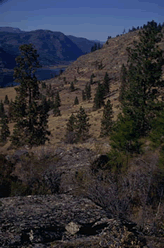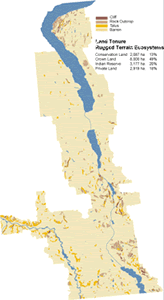|
(published
1998)
Habitat Atlas
for Wildlife at Risk
Rugged Terrain Ecosystems
 The
towering cliffs and rocky ridges that frame the South
Okanagan and Similkameen valleys are important habitat
for many species of birds, mammals and reptiles. Eleven
species of Red- and Blue-listed vertebrates are associated
with this ecosystem. The precipitous bluffs provide
escape terrain for California bighorn sheep, especially
important during the spring lambing season. Birds such
as Golden Eagles, Peregrine and Prairie Falcons, Turkey
Vultures and White-throated Swifts also use cliff ledges
and crevices as safe sites to raise their young each
year. Many bat species raise their young in carefully
selected, sun-warmed crevices, high within cliff faces. The
towering cliffs and rocky ridges that frame the South
Okanagan and Similkameen valleys are important habitat
for many species of birds, mammals and reptiles. Eleven
species of Red- and Blue-listed vertebrates are associated
with this ecosystem. The precipitous bluffs provide
escape terrain for California bighorn sheep, especially
important during the spring lambing season. Birds such
as Golden Eagles, Peregrine and Prairie Falcons, Turkey
Vultures and White-throated Swifts also use cliff ledges
and crevices as safe sites to raise their young each
year. Many bat species raise their young in carefully
selected, sun-warmed crevices, high within cliff faces.
 Talus,
or scree, is the rocky debris which accumulates at cliff
bases. Talus provides good cover for wildlife, especially
snakes, lizards, mice and even some birds. Rattlesnakes
and night snakes hibernate in deep chambers below the
ground in talus and broken rock, while racers and gopher
snakes are often seen sunning themselves on the warm
rocks in spring. The beautiful, cascading song of the
Canyon Wren is heard in Canada only in the South Okanagan,
almost always from large talus at the base of high cliffs. Talus,
or scree, is the rocky debris which accumulates at cliff
bases. Talus provides good cover for wildlife, especially
snakes, lizards, mice and even some birds. Rattlesnakes
and night snakes hibernate in deep chambers below the
ground in talus and broken rock, while racers and gopher
snakes are often seen sunning themselves on the warm
rocks in spring. The beautiful, cascading song of the
Canyon Wren is heard in Canada only in the South Okanagan,
almost always from large talus at the base of high cliffs.
The physical difficulties in altering this rocky, rugged
habitat has largely saved it from agricultural and urban
developments in the South Okanagan. Rugged terrain is
a patchy ecosystem, however, and many examples in the
valley have become islands in a sea of cultivated and
urbanized lands. This lack of natural movement corridors
may result in many species disappearing from isolated
patches without an opportunity for recolonization from
nearby rock outcrops.
Threats:
- Developments on land adjacent to cliffs can restrict
wildlife species' access to escape routes, travel
corridors and feeding areas.
- Heavily used rock climbing sites may have an impact
on bird nesting and bighorn sheep use for lambing.
- Exploitation of talus for rip-rap.
Wildlife at Risk for which this habitat is
critical
Red
List
- Night Snake
- Ferruginous Hawk
- Peregrine Falcon
- Prairie Falcon
- Pallid Bat
|
Blue List
- Gopher Snake
- Western Rattlesnake
- Racer
- Canyon Wren
- White-throated Swift
- Small-footed Myotis
- Spotted Bat
- California Bighorn Sheep
|

|